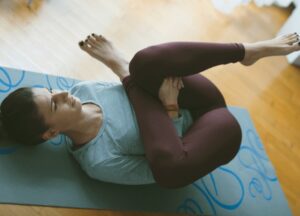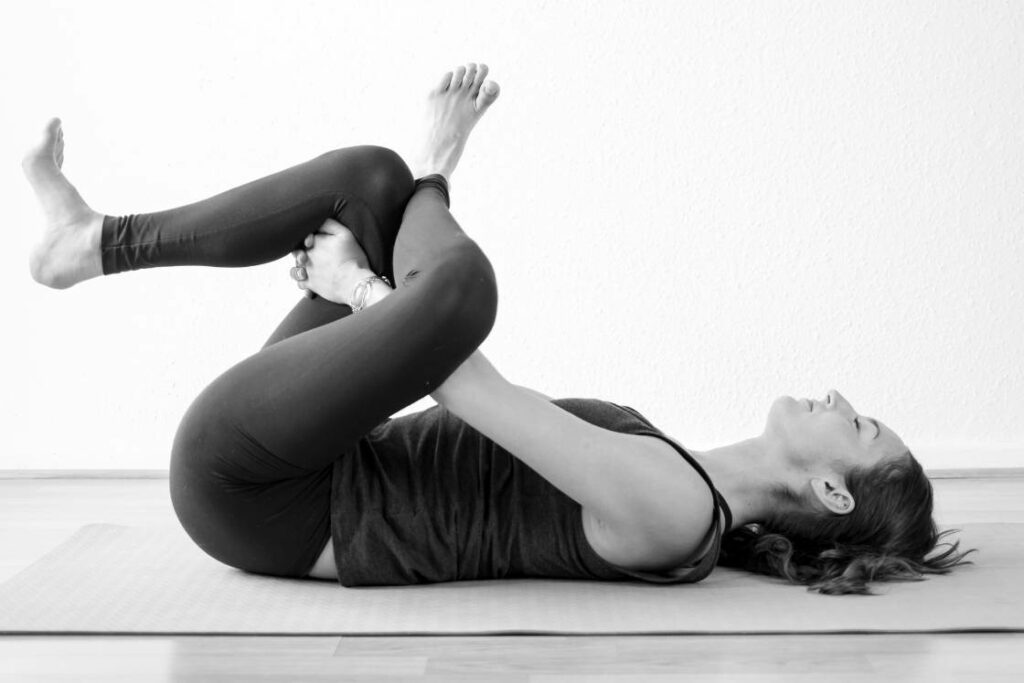Do you want to learn how to do the reclined pigeon pose? This is a yoga pose that is known for being very relaxing and stress-relieving. It can be a little bit challenging to get into at first, but with a little practice, you will be able to do it like a pro! In this guide, we will discuss the benefits of the reclined pigeon pose, how to do it correctly, and some tips for improving your practice. Let’s get started!
Contents
What Does Reclined Pigeon Pose Mean?
 Reclined pigeon pose is an advanced yoga pose that requires both flexibility and strength. The Sanskrit name for this pose is Supta Kapotasana, which literally means “reclining pigeon.” This pose opens up the hips and stretches the glutes, hamstrings, and inner thighs. It also helps to relieve lower back pain.
Reclined pigeon pose is an advanced yoga pose that requires both flexibility and strength. The Sanskrit name for this pose is Supta Kapotasana, which literally means “reclining pigeon.” This pose opens up the hips and stretches the glutes, hamstrings, and inner thighs. It also helps to relieve lower back pain.
It is believed that the pose gets its name from the way that the body resembles a pigeon when in the final position. The back leg is extended straight behind the body, while the front leg is bent at the knee and tucked under the chest. The arms are extended out to the sides, forming a T-shape with the body.
This pose can be challenging for beginners, so it is important to practice with a qualified instructor before attempting it on your own. With the right guidance and some practice, you will be able to enjoy the many benefits of reclined pigeon pose.
How To Perform Reclined Pigeon Pose?
This is a beginner’s guide on how to perform the reclined pigeon pose. The reclined pigeon pose is a great way to stretch your hips and glutes. It’s also a good way to release tension in your lower back.
To do this pose:
- Start by lying on your back with your knees bent and your feet flat on the ground.
- Bring your right ankle to your left knee and use your right hand to hold your left shin.
- Gently pull your left leg towards your chest.
- You should feel a stretch in your glutes and hips.
- Hold this pose for 30 seconds and then switch sides.
The position of your left leg in this pose is very important. Make sure that your left shin is parallel to your mat. If your left shin is not parallel to the mat, you will not get the full benefit of the stretch.
If you want a deeper stretch, you can try this variation of the reclined pigeon pose. To do this variation:
- Start by lying on your back with your knees bent and your feet flat on the ground.
- Bring your right ankle to your left knee and use your right hand to hold your left shin.
- Gently pull your left leg towards your chest.
- Now, place your left elbow on the ground next to your left hip.
- Use your left arm to gently push your left leg away from your body.
- You should feel a deeper stretch in your glutes and hips.
- Hold this pose for 30 seconds and then switch sides.
If you have any pain in your knees or back, please stop immediately and consult a doctor. Reclined pigeon pose is a great way to stretch your hips and glutes, but it’s important to listen to your body and not overdo it.
What Are The Benefits Of Reclined Pigeon Pose?
 Many people think of the pigeon pose as a deep hip opener, and while that is one of the benefits, there are many others. Here are some of the benefits you may experience from practicing reclined pigeon pose:
Many people think of the pigeon pose as a deep hip opener, and while that is one of the benefits, there are many others. Here are some of the benefits you may experience from practicing reclined pigeon pose:
- Improved flexibility in the hips
- Increased range of motion in the hips
- Stretches the glutes and piriformis
- Relieves tension in the lower back and sciatic nerve
- Improves digestion
- Reduces stress and anxiety
These benefits are often considered the most important, but there are many others that are worth mentioning. If you have any specific concerns or questions, be sure to ask your doctor or yoga instructor before beginning this or any other yoga pose.
Because each person is unique, you may experience different benefits from practicing reclined pigeon pose. Just remember to listen to your body and never push yourself too hard. With regular practice, you should start to see and feel the positive effects of this pose.
What Muscles Are Targeted In Pigeon Pose?
When you do a regular pigeon pose, you target the following muscles:
- Psoas muscle
- Iliacus muscle
- Gluteus medius muscle
- Piriformis muscle
- Superior gemellus muscle
- Inferior gemellus muscle
- Quadratus femoris muscle
- Tensor fasciae latae muscle
When you do a reclined pigeon pose, you target all of the above muscles, plus the following:
- Rectus abdominis muscle
- External oblique muscle
- Internal oblique muscle
- Transverse abdominal muscle
- Quadratus lumborum muscle
The pigeon pose is an excellent way to stretch out your hips, as well as your back and shoulders. It’s also a great way to release tension in your lower body. If you’re looking for a challenge, try doing a reclined pigeon pose. This variation of the pose targets even more muscles, including your abdominal muscles.
If you want to improve your muscle strength, and flexibility and reduce pain in your lower body, the pigeon pose is an excellent choice. So, do not hesitate to give it a try!
What Conditions Can It Treat?
 While it might seem just a simple, passive stretch, the reclined pigeon is a therapeutic pose that can offer relief from a variety of conditions.
While it might seem just a simple, passive stretch, the reclined pigeon is a therapeutic pose that can offer relief from a variety of conditions.
- Sciatica: It is a condition where the sciatic nerve, which runs from the lower back down the legs, becomes pinched or irritated. This can lead to pain, numbness, and tingling in the lower back, buttocks, and legs.
- Piriformis Syndrome: This is also treated by pigeon pose by stretching the piriformis muscle, which is located in the buttocks. This muscle can become tight and inflamed, leading to pain in the buttocks and legs.
- Low Back Pain: The reclined pigeon pose can help to release tension in the lower back by stretching the psoas muscle, which runs from the lower back to the top of the thigh.
- Hip Pain: If someone is experiencing pain in their hips, it is likely because the hip joints are not moving as they should. Practicing this pose can help to increase mobility in the hips and reduce pain.
- IT Band Syndrome: The IT band is a long strip of connective tissue that runs down the side of the thigh. When this becomes tight and inflamed, it can cause pain in the hips and legs.
- Groin Pain: It is a type of groin pain that is caused by an inflammation of the adductor muscles, which are located in the inner thigh. These muscles can become tight and painful, but the pigeon pose can help to stretch and release them.
So, many conditions are treatable with the pigeon pose! If you are experiencing any of the above, give it a try. It is a gentle pose that can offer great relief. Just be sure to listen to your body and only go as far as you feel comfortable.
Who Should Not Consider Pigeon Pose?
Generally, this is a good pose for all levels, but if you have the following issues, check with your doctor before doing this or any other yoga pose:
- Heart conditions
- High blood pressure
- Glaucoma ( We provide Effective Glaucoma Surgery)
- Detached retina
- Carpal tunnel syndrome
Pigeon Pose is an effective way to open the hips and release tension in the lower back and buttocks. If you have any of the above issues, please do not attempt this pose without the guidance and permission of a physician.
Moreover, if you are pregnant, have a hernia, suffer from migraines, or have diarrhea, you should also refrain from doing this pose. This can be a very intense hip opener, so if you have any injuries in the knees, ankles, or hips, please take caution and listen to your body. If anything feels sharp or painful, back out of the pose immediately.
What Are Some Tips To Improve The Practice?
 There are some effective tips that can help you improve your practice of reclined pigeon pose. Below are some key tips to consider:
There are some effective tips that can help you improve your practice of reclined pigeon pose. Below are some key tips to consider:
- To deepen the stretch in the hip, place a block or pillow under the bent leg.
- If the front leg is not resting on the floor, place a yoga strap around the ankle and hold onto it with both hands. Gently pull the leg towards you.
- For a more gentle stretch, place a blanket under the bent knee for support.
- Remember to keep the back leg straight and resist the temptation to bend it. This will help prevent injury and ensure you get the most out of the pose.
When practicing reclined pigeon pose, it is important to listen to your body and go at your own pace. If you feel any pain, stop immediately and consult a doctor or certified yoga instructor. With regular practice, you will eventually be able to achieve the full expression of the pose.
And you should also focus on your breathing. Inhale and exhale slowly and deeply through the nose. This will help you relax the body and ease into the stretch. Overall, just be patient and consistent with your practice and you will eventually improve.
Conclusion
In a nutshell, reclined pigeon pose is a hip opener that’s great for beginner and intermediate yogis alike. It’s a simple, yet effective, way to stretch the hips and release tension in the glutes. If you’re looking for a pose to add to your yoga practice, give reclined pigeon pose a try! You might be surprised at how much you enjoy it.
Physical Therapy has always been proven to help patients recover from pain. Hence, if you’re experiencing Back pain, Shoulder pain, Knee pain, Neck pain, Elbow pain, Hip pain, or Arthritis pain, a physical therapist at MantraCare can help: Book a physiotherapy session.


